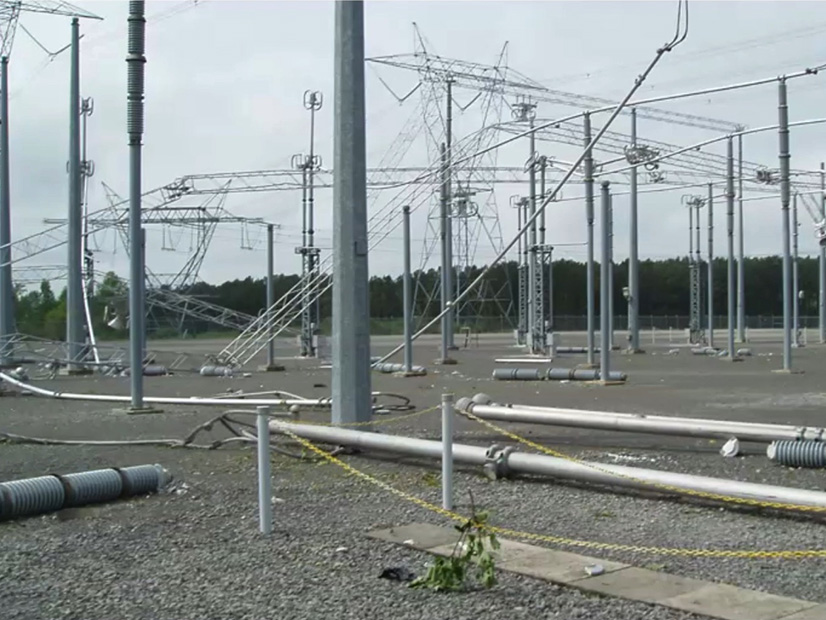With another active Atlantic hurricane season expected for 2021, participants in SERC Reliability’s spring extreme weather webinar on Tuesday urged utilities to invest time and effort into preparation now, in order to prevent delays in restoration when natural disasters hit.
The hurricane season runs from June 1 to Nov. 30, and a recent forecast from the Weather Channel predicted 19 named storms; that total includes eight hurricanes, four of which are projected to be major hurricanes of Category 3 or higher. By comparison, there was a record 30 named storms last year, including 14 hurricanes — the most since the 15 hurricanes of 2005, with six of them major.
The National Oceanic and Atmospheric Administration has not released its own predictions for 2021 yet, but the agency noted last month that its estimate of an “average” hurricane season now means 14 named storms and seven hurricanes, three of them major. The average is calculated based on the last 30 years of storm data and revised every 10 years — most recently this year to reflect 1991 to 2020. NOAA identified several possible causes for the increase: a “warming ocean and atmosphere … influenced by climate change,” but also longer-term climate patterns and better observation technology.
Growing Grid Challenges
Combined with increasingly destructive hurricane seasons is the ongoing challenges from the COVID-19 pandemic. Despite progress in vaccinations, attendees at Tuesday’s webinar are expecting social distancing measures and use of personal protective equipment to be as prevalent in 2021 as they were last year. (See Pandemic Adds to 2020 Hurricane Season Challenges.)
Several participants, including SERC Vice President of Operations Tim Ponseti, noted the frequent occurrence of one-in-100-year events in recent decades — such as the pandemic, February’s extreme winter weather in Texas and the Midwest, and last year’s wildfires in California and earthquake in North Carolina — as indications of the growing risks facing grid planners and operators.
In his keynote, Charles Long, vice president of transmission planning and strategy at Entergy, referred to a quote commonly attributed to Dwight Eisenhower (“Plans are useless, but planning is indispensable.”) to illustrate the benefits of aggressive preparation even in the face of unpredictable events.
“Just know, going into these events, that your plan isn’t going to be perfect; in fact, you may discover in the heat of battle that your plan isn’t really that good at all,” Long said. “But the fact that you did the planning diligently will pay off and help you shorten the restoration … [and] after each event, you can incorporate what you learned … to improve the areas you struggled in for the next one.”
Long emphasized that incident response is a “continuous process” that requires “preparing well in advance and then practicing either through drills or real events.” In his experience the most effective planning begins months in advance of an event, when organizations engage the entire workforce in building reserves of critical equipment and developing incident response plans.
During the days and hours before impact, as the specific threat becomes more clear, entities can implement unified communication strategies so that external and internal messaging is cohesive; stage personnel and equipment; and prepare to document all decision-making. The last step ensures a record that can be used after the event as utilities analyze their successes and failures.
TVA Shares Staging Success Story
A 500-kV substation in Alabama, operated by the Tennessee Valley Authority, served as an example of the way post-event analysis can assist in future recovery. After a tornado damaged the facility in 2014, TVA found itself without convenient access to spare parts for repair.
Typically the organization would find such equipment from construction projects going on elsewhere in its footprint, but at the time there were no such projects underway — at least, not in the quantity needed for this restoration.
“That forced us to have to order this material basically from scratch,” said Casey Scoggins, manager of substation physical engineering at TVA. “So, based on the fact that we had long leads, we had vendor issues because we [were] trying to rush them. … It took basically a year to get this station back to normal.”
After this costly experience, TVA management saw improving the spare parts supply chain as a “no-brainer.” The organization undertook a multiyear overhaul of its practices, focusing on both acquiring and storing the needed parts. Equipment is now kept in large warehouses in Alabama, Tennessee and other states, from which it can be distributed quickly to areas where it might be needed ahead of potential incidents.
This process did not go entirely smoothly: TVA did have to work out some kinks in delivery. One issue arose when the organization found out that some vendors had mixed various parts in the same package for more efficient delivery, which could have caused difficulties if the packages had been deployed to field crews without inspection. TVA is currently working with vendors on their packaging procedures to prevent such mix-ups in the future.
However, even with these complications the supplies were in place by last year. The preparation paid off this March, when the same substation was once again hit by a tornado, causing comparable damage to the 2014 incident. This time, the needed parts were available within days, and the facility is expected to be fully restored to service by the end of this month, preventing another long delay in restoring service during a critical time of year.
“This was one of our first rounds of severe storms for this year, and you don’t really know how many more rounds could be coming, especially having all of April and May to go,” said Michael McAmis, principal engineer at TVA. “So [when] getting this station back … one of the primary drivers was system resilience.”






